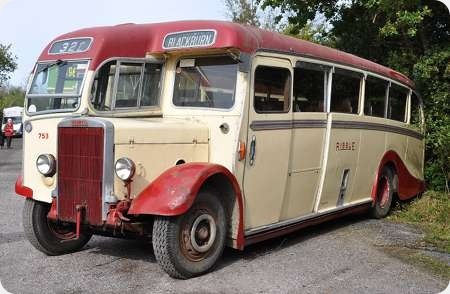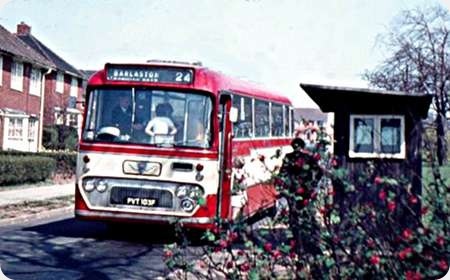
Ribble Motor Services
1936
Leyland Tiger TS7
Duple C31F
FV 5737, Leyland Tiger TS7, was new to W C Standerwick of Blackpool in 1936. In the post-war years, she was transferred across to the Ribble fleet and given this Duple C31F body in 1950. In the renumbering system, she became 753. She’s seen at the Winkleigh Open Day on 7 October 2012.
Photograph and Copy contributed by Pete Davies
14/02/15 – 13:03
It would appear that the petrol engine was changed for an oil engine at the same time as the re-body. It still kept its starting handle but I doubt it was ever used I have heard you could do yourself some serious injury if you didn’t get it quite right.
Trevor Knowles
14/02/15 – 17:14
These had been rebodied with 8ft. wide bodies, resulting in a nice looking coach, just spoilt by having to retain the original 7ft 6in. wide axles and resulting in the wheels being set back inside the wings and wheelarches. I suppose since prewar chassis were never built to the greater width, the wider axles would not be available as they would be with postwar models.
John Stringer
14/02/15 – 18:21
Trevor, I have heard a similar story about fairly serious consequences arising if the user of the starting handle didn’t keep out of its way!
Yes, John, it does skew the appearance a bit, but I suppose the other side of the coin is that the wheels are further into the mudguards, so there’s less of a "splash factor" for other road users to suffer.
Pete Davies
16/02/15 – 06:48
I served a 6 year apprenticeship at Ribble main workshop Frenchwood Preston till about 1961. I do remember foreman Sid Liptrot using a heavy chain to start a diesel Tiger, must have been mad. The petrol engine Cheetah sounded like a Rolls Royce. Probably best company in UK.
Raymond Hollebone
24/09/19 – 04:22
New in 1935 and rebodied in 1948 (I should know I spent my childhood on 753 rallying every weekend).
Peter Robinson
Quick links to the - Comments Page - Contact Page - Home Page

Copyright Unknown
United Oxford Hospitals
1948
Bedford OB
Mulliner B31F
Bedford OB NWL 804 chassis 91874, with Mulliner B31F body number T324 was new in November 1948 to United Oxford Hospitals and is thought to have been attached to Churchill Hospital at Headington. In this view, it appears to have bars at some windows in the same fashion as sometimes applied to similar buses for service with the police. Ironically, for a hospital bus, it is carrying a healthy load. Photo purchased five decades ago, copyright unknown.
Photograph and Copy contributed by Les Dickinson
05/02/15 – 06:32
Les, are you sure the bars are not just the frames of two half-drop windows ?
A nice little bus though.
John Stringer
05/02/15 – 06:32
Are they bars, or just half-drop windows?
Stephen Ford
05/02/15 – 16:27
Yes I’m sure they’re half drop windows as the metal tops to the fixed lower panes can clearly be seen level with each other. Considering that Mulliner bodies were usually for unpretentious working vehicles they turned out some very pleasing designs indeed – the hordes of Military buses, all three services, were grand looking vehicles.
Chris Youhill
06/02/15 – 06:44
This particular design of bus body for the OB was designed by Duple, being a development of the OWB utility body, and known as the Mk.II. After building a few, Duple found their production lines overwhelmed with building Vista coaches, and so in 1947 sub-contracted a batch of Mk.II’s to Mulliner’s of Birmingham. Two bodies are known to have been sent to Mulliners to assist in producing jigs. Following the sub-contracted batch, further orders were passed by the Vauxhall dealers directly to Mulliner’s, who continued to supply the design until 1950, very many of which were exported – especially to oil companies in the Middle East or South America. Dealers are believed to have referred to the Mulliner-built bodies as Mk. III. In 1949 Duple came up with a new, more stylish bus body known as the Mk. IV, and recommenced production of bus bodies for OB’s, being produced simultaneously with the older style Mulliners.
John Stringer
Quick links to the - Comments Page - Contact Page - Home Page

Potteries Motor Traction
1968
AEC Reliance 691 8U2RA
Alexander DP49F
SL1103 is at the Barlaston terminus of services 24/25 having worked the service from Hanley on 3rd May 1970. Barlaston was a pleasant village on the south eastern side of the Stoke conurbation, it’s main fame at that time being the nearby Wedgwood China factory. This was one of PMTs second batch of these Reliances, differing from the previous delivery in having folding doors in lieu of glider type. Both batches had low back dual purpose seating. The 8U2R chassis specification denotes coil spring suspension. The ride on these could be quite bouncy when the shock absorbers were in less than good condition.
Photograph and Copy contributed by Ian Wild
20/02/15 – 16:31
The last couple of years of its life were spent at the Newcastle under Lyme depot I loved this bus I remember one weekend on the Saturday doing express to Skegness and being relieved at Newark on the way back, I then travelled on the cushions back to Depot. Next day I took it to Blackpool on excursion. I probably drove this vehicle more than any one else whilst it was at Newcastle some one wrote in the cab "Croftys bus" another favourite
Route was express to Peterborough Saturday’s only. It was great on service as well. Happy days.
Michael Crofts
02/05/20 – 06:48
Looking at a PMT Fleetlist for May 1979 it stated that most of the Alexander Y type Reliances had AH590 engines. This begs the question, was the AH691 unreliable or was there a difficulty in obtaining spares? I recall seeing several former Maidstone & District Reliances dating from 1965 passing through the Central Works at Stoke for parts recovery and so some of the AH590 engines could have been sourced from these. Likewise at least one former North Western Reliance was received from Crosville for the same reason.
Leekensian
03/05/20 – 06:34
Could be that the fleetlist is wrong. The AH691 gradually replaced the AH590 from 1967 and by 1969 had done so completely. The 8U2R was a variant of the 6U2R – which only ever had (initially) the AH691 and (latterly) the AH760.
David Oldfield
04/05/20 – 05:46
David, the fleetlist was included in a publication issued by PMT in 1979 entitled ‘a century of public transport in North Staffordshire’. The fleetlist states that buses 1092 to 1096, 103 to 109 and 161 to 163 as 8U2R with AEH691 engines, whilst fleet numbers 164 to 173 as 6U2R with AH691 engines. However there is a footnote along side the entries stating – most have AH590 engines.
Leekensian
05/05/20 – 05:52
The 8U2R Reliance had coil spring suspension (very few built), the more common 6U2R had conventional leaf Spring suspension.
Ian Wild
05/05/20 – 05:53
Confirmation, FEH 171J fleet number 171 had a AH691 engine.
Alan Coulson
06/05/20 – 07:06
All the Alexander Y type bodied Reliances were supplied with AH691 engines. From memory, the cylinder liners in this engine were a VERY tight fit in the parent bore (figures of 20 tons needed on the press come to mind). It could be that as the engines aged, the cylinder blocks got past having new liners fitted and fitting redundant AH 590 engines in place could well have been a more economical method of keeping elderly vehicles running.
Ian Wild
Quick links to the - Comments Page - Contact Page - Home Page



